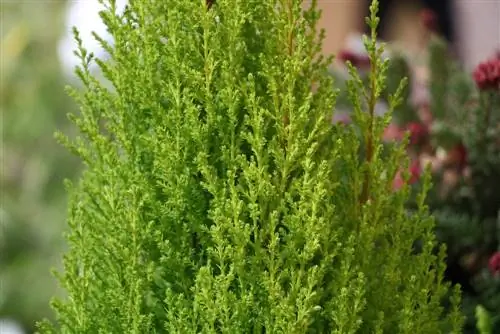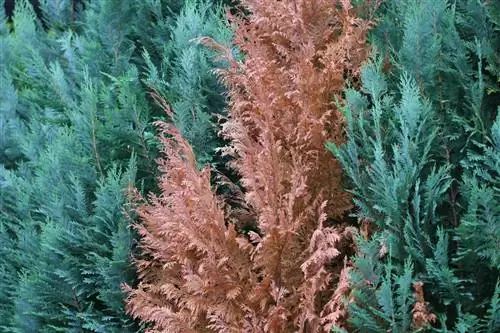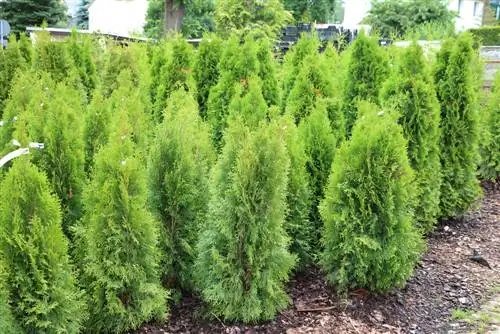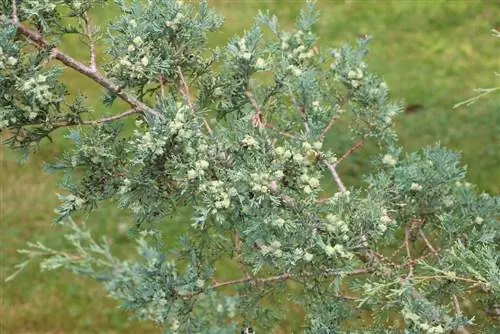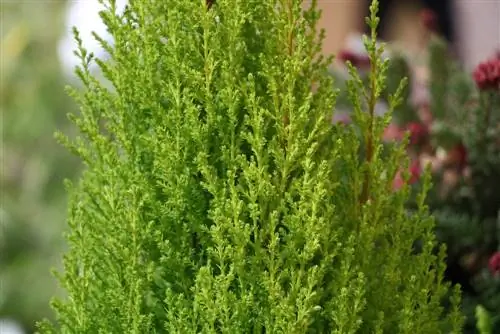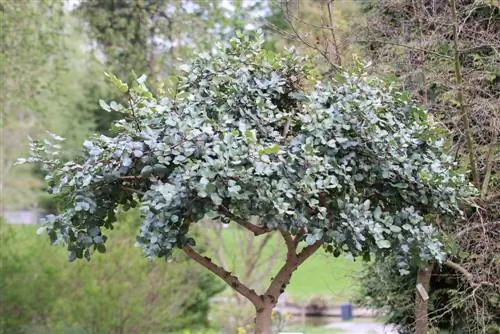- Author admin [email protected].
- Public 2023-12-17 03:39.
- Last modified 2025-06-01 06:48.
In the ranks of popular potted plants, conifers also join many other plants. Thuja, cypress and rocket juniper are equally suitable for cultivation in a larger pot. Their soft foliage varies from light to dark green to bluish hues depending on the species. Whether as a solitary plant or in a group, conifers in pots look extremely charming.
What are conifers?
The term in biological systematics is made up of the Latin words “conus” for “cone” and “ferre” for “carry”. When the two are combined, they are called “cone carriers”. However, the expression “needlewood” has become established in German usage. Experts occasionally talk about Coniferales or Pinales. The cones are female spike-shaped fruit heads that become woody over time. Seeds ripen under the scales. In arborvitae and cypress plants, the fruits are berry-shaped. Nevertheless, the correct definition is tenon. This also applies to the juniper, where the scale leaves become fleshy and develop into a pea-sized fruit.
What advantages do conifers offer?
Coniferous trees are an integral part of garden design. The popularity is no coincidence, as conifers come up with a number of convincing arguments:
- evergreen (exception: larch)
- offer privacy protection all year round
- no falling autumn leaves
- green splashes of color in winter
- frost-tolerant
- easy care
Deciduous trees would die of thirst if they kept their leaves in winter. All woody plants use their roots to draw water and nutrients from the soil and transport it through the trunk, branches and twigs to the leaves. Evaporation occurs through the leaves, so supplies must be constantly supplied. When the ground is frozen, this cycle ceases to be effective.
To protect against drying out during the cold season, deciduous trees shed their leaves in autumn. Needles have a thick layer of wax and have a small surface area, which significantly reduces evaporation. This is why conifers can keep their needles in winter. The same principle applies to the scale leaves of the cypress family.
Why cultivate conifers in a container?
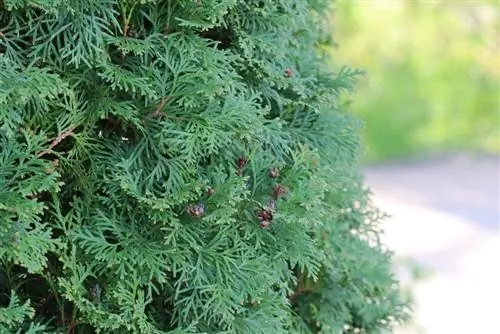
In times of constantly rising prices for building land, the garden is becoming relatively small for more and more house builders. On the other hand, many buildings located in town centers have a tiny or no green area. There may only be a paved courtyard that does not allow for direct planting in the ground. If you own a condominium, you usually don't have a garden, just a terrace or balcony. None of these variants provide a valid reason for avoiding conifers.
Because wherever there is a lack of space, keeping in a bucket is a good idea. On the other hand, there are garden owners who prefer a planter for various plants despite having a large footprint. The ability to move a plant to the side or move it to another location when necessary sometimes proves to be very practical. Below are a few suggestions for locations where conifers in pots look great:
- right and left of the entrance
- next to a staircase
- for edging a bench
- in front of the house
- Decoration of the terrace
- on the balcony
- as demarcation for separate areas
Size of the bucket
The pot highlights the natural expressiveness of the conifer. What size should it be so that thuja, cypress or other conifers thrive in it? A rule of thumb says that a pot diameter of 30 to 40 cm is required for a height of one meter. Taller conifers need correspondingly more volume. Conifers are generally shallow-rooted, but the minimum vertical dimension should correspond to the width. For very small trees, twice the height and width of the root ball is initially sufficient. If the plant grows in size over time, it needs to be moved to a more spacious container.
Tip:
If possible, choose a slightly larger pot so that the coniferous plant can gain a proper foothold.
Which bucket?
The pot for the conifer has to be pleasing first and foremost. But before your personal taste influences your purchase decision, you should also think about the material. Specialist retailers currently have buckets available in the following materials:
- Terracotta: often not hardy
- Earthenware/ceramic: fragile, not frost-proof
- Concrete: heavy, unwieldy
- Zinc: durable
- Plastic: light and inexpensive
- Polyrattan: modern
- Fiberglass: high strength
- Aluminum: robust, low weight
- Stainless steel: looks very elegant
- Rust steel (Corten steel): rustic
- Wood: insulating, close to nature
- Bamboo: decorative

If the bucket stays in the same place all the time, its weight plays a minor role. However, if you know from the outset that the plant pot will have to be moved away from time to time, you should choose light materials (plastic, zinc, aluminum). Alternatively, mobile stands serve well. Conifers that remain outdoors all year round require a frost-proof container.
Wet earth expands when frozen and cracks pottery and ceramic pots. When using plastic, it is advisable to pay attention to the “UV-resistant” label. Without this property, the colors fade when exposed to sunlight and the material becomes brittle. If the label that indicates light fastness is missing, pots will look old and worn after just one season.
Conifer substrate
In the pot, plants cannot make full use of the soil. Unlike outdoor planting, they are dependent on the quantity that is offered to them in their habitat. In order for them to still be full of he alth, they need a substrate that provides them with all the important nutrients. Commercially available special soil for conifers has the properties that are expected from the plants:
- slightly sour
- ph value 3.5 - 4.5
- humus-rich
- retains moisture
- permeable
- mostly supplied with starting fertilizer
Tip:
If you compost yourself, you can mix some home-made humus with the purchased conifer soil.
Thuja, cypress and rocket juniper in a pot
Cypress plants, which from a botanical point of view also include thuja and juniper, look overall fuller than the native coniferous trees fir, spruce and pine due to their scale-shaped leaves. The denser growth makes these conifer genera welcome components in the garden. The essential oils in the leaves and young twigs also spread an aromatic scent. When keeping in containers, preference should be given to species that grow slowly and not excessively tall. Please note that the plants require a little more care than when kept outdoors and, in order to prevent frost damage, may need heat protection wrapped around the pot in winter.
Planting

Spring and autumn prove to be the perfect planting times. Conifers cannot tolerate extremely wet conditions. There is a risk that the roots will rot in the pot. Excess water can drain out through a pot base with an opening. To be on the safe side, you should add a drainage layer at the very bottom so that water does not build up around the roots. When it comes to putting them in the pot, there are no significant differences between thuja, cypress and rocket juniper. Therefore, here are summarized instructions for potting for all three variants:
- Immerse the roots of container plants in water until no more bubbles appear
- Put bare-root plants in water for at least one hour
- Fit the bucket with an approximately 2 cm thick layer of drainage (gravel, pottery shards, expanded clay)
- Insert a fleece to separate it from the ground
- Fill in layer of conifer substrate
- Place the plant in the middle of the pot
- pour soil around the roots
- Press substrate
- Leave 3-5 cm free to the edge of the bucket (so that the bucket doesn't overflow when watering)
- Water well
Watering
In the open field, dry weather is usually not a problem for conifers, unlike plants in pots. During heat and long periods without rain, the water supply quickly stalls due to the limited volume in the bucket. Make sure that the soil always has a certain moisture content. As the summer progresses, the watering can may need to be used every day. Too much of a good thing can also have a negative impact. Extreme wetness promotes the formation of mold and hinders the roots from absorbing nutrients. Watering correctly means:
- wait until the soil has dried
- Do not wet the above-ground parts of the plant, but pour directly onto the substrate
- Water temperature not colder than ambient temperature
- water in the morning or evening - not in midday heat (otherwise water will evaporate immediately)
- daily watering is usually necessary in summer
- Spring and summer: about twice a week
- Do not leave water in the saucer for a long time (waterlogging!)
- also be careful in winter that the soil does not dry out (do not water in severe frost)
Fertilization
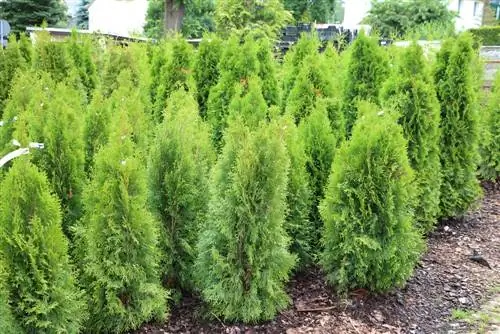
Initially there is no need for fertilization because the conifer substrate initially contains enough nutrients. After 2-3 months this supply is used up. In order to avoid deficiency symptoms in the plant, you should then supply the conifers with liquid fertilizer via irrigation water every four weeks. From the end of August there is no more fertilization so that the plant can prepare for winter. The next nutrient doses are not due until early spring. Long-acting fertilizers only need to be applied once or twice a year.
Tip: Dry coffee grounds every now and then and work them into the substrate. The residue from coffee preparation contains, among other things, nitrogen, phosphorus and potassium and has a slightly acidifying effect.
Thuja - special features:
- Location: sunny to partially shaded
- may be sensitive to drafts
- regular cut for dense growth
- relatively hardy
- Dwarf forms: “Teddy”, “Tiny Tim” and “Little Giant”
Special characteristics of the cypress:
- choose hardy cypress trees
- add some sand to the soil
- Location: sun or partial shade
- needs winter protection when kept in a pot (wrap the pot with bubble wrap, coconut mat or burlap)
- small species: “Baby Blue”
Rocket juniper in detail:
- typical heather plant
- Location: as sunny as possible
- grows tightly upright
- well tolerates frost
- loves nutrient-poor soils (fertilize only a little!)
Further care measures
Weeds will certainly grow next to the plants after some time. If it is still small, it is easy to weed. Take this opportunity to loosen the soil a little with a hand hoe or fork so that oxygen can reach the roots. But be careful not to damage any roots. Thuja, cypress and juniper plants are very tolerant of pruning. If the trees in the pot blow up the originally intended frame, you can boldly grab the scissors, but not into the old wood, because the branches will no longer sprout there.
It's better to trim a little more often than radically once. Ideally, pruning takes place in spring or autumn. With imagination, patience and possibly the help of a stencil, interesting shapes and sculptures can be created. The rocket juniper grows upwards as a slender column. With this conifer, only the shoots above are usually shortened.
Tip:
If the container is large enough, underplanting with low flowering plants (e.g. pansies or verbena) provides color. If you choose bulbous plants (crocuses, mini daffodils), you should plant them in autumn because they need a cold period before they bloom.

